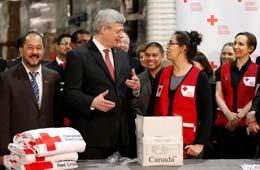Canadians donate $85 million to help Typhoon Haiyan victims

Canadians have poured in some $85 million to help victims of super Typhoon Yolanda (Haiyan) that struck the Philippines last November and Ottawa is now set to match the donations as part of its pledge.
But questions are now being asked as to where the millions that have been pumped into the Philippines in cash and assistance have gone and will go.
After super Typhoon Haiyan struck the Philippines last November, foreign governments and aid groups pledged some $600 million in cash and assistance for the relief and recovery effort.
Now, the Philippine government says it can only account for some $14.3 million of the donations. The government is working to create an improved tracking system to find out where the money went, a VOA report said.
Right now the “Foreign Aid Transparency Hub” website shows pledges to three Philippine government agencies, but there are holes in the data.
Presidential spokesman Edwin Lacierda admits that the website does not reflect where exactly the money is going. But he says the government will remedy that situation this month with an updated version that will provide more transparency.
“We are not going to only track donations to government, but also [what] those pledges and assistance have been converted to and to what channels- what we call channels- or organizations that they’re going to be furnished to," said Lacierda.
For the new version, the Philippines will require foreign governments to submit detailed information of where their pledges have gone. Authorities say this will help them account for much more of the donated funds. As for tracking what the Philippine government has received directly, Lacierda says those agencies are still putting together reports of where the money was spent.
Cleo Calimbahin, the executive director of Transparency International-Philippines, commends the government for creating the website, but she says it is “not very informative.” And even with additional information in the new version, the huge gap between pledges versus cash accepted might not necessarily close.
“A lot of private organizations and agencies channeled some of [that] aid directly to their counterparts… and that would be very difficult to track. Also difficult to track would be aid that was given directly to local governments… because sometimes these local governments have strong relationships with other countries directly,” she said.
After five months of recovery and reconstruction efforts in Tacloban and other hard-hit areas, there is still a great need for more assistance. Just this week, Australia pledged another $27 million for reconstruction in typhoon-hit areas, on top of the $36 million Canberra pledged in November.
Last Nov. 10, Canada established the Typhoon Haiyan Relief Fund, where every eligible dollar donated by individual Canadians from November 9 to December 23 would be matched by the government.
Prime Minister Stephen Harper announced last week that individual Canadians contributed over $85 million in eligible donations that our Government is matching through its Typhoon Haiyan Relief Fund.
“Our Government worked closely with the Filipino-Canadian community, humanitarian partners and the Government of the Philippines in the aftermath of Typhoon Haiyan to identify priorities and quickly provide emergency assistance where it was needed most. The Typhoon Haiyan Relief Fund was a success and our Government is proud to play a role in matching the generosity of Canadians,” said Harper.
“I am deeply proud of the way Canadians came together to help the people of the Philippines in the aftermath of Typhoon Haiyan. The remarkable support that Canadians provided both here at home and the very strong presence of both our DART team and humanitarian partners on the ground, especially on Panay Island, made us a global leader in helping address the impact of the crisis.”
Leave a comment






